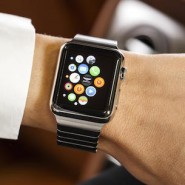By Alex Samuely of Mobile Commerce Daily
Although the art of purchasing via Apple Watch applications has not yet reached its zenith – with 24 percent of consumers wary of making impulse buys on the wearable – retailers can fuel sales by offering in-store shoppers easy access to coupons and loyalty programs, according to a GPShopper report.
The report, “Cracking the Mobile Code: The Apple Watch and Retail,” revealed that 23 percent of Americans would consider purchasing the next incarnation of the Apple Watch, although nearly 24 percent of that group would refrain from buying products on it, due to concerns about making an impulsive purchase. Although the Apple Watch may not serve as the most lucrative primary purchasing channel, retailers can still leverage their wearable-friendly apps by making coupons and loyalty rewards easily accessible for individuals needing an incentive to make an in-store purchase.
"The most critical takeaway that retailers need to pay attention to is that people are interested in buying the Apple Watch but, at this point, they just aren’t looking to make sizable purchases on the device,” said Maya Mikhailov, co-founder and chief marketing officer of GPShopper. “The fact that 63 percent of consumers wouldn’t spend more than $100 on the Apple Watch should be a wake-up call for retailers that have Apple Watch apps or are in the process of developing one.
“That’s not necessarily a bad thing — it’s just that retailers have to stop thinking about mobile as a way to simply recreate their online catalogs like they did on desktop. The real opportunity for retailers in the Apple Watch is to engage shoppers and tie the device into the broader mobile shopping experience in both stores and online.”
The report was conducted alongside research firm YouGov.
Complementary Apple Watch tactics
The Apple Watch can perhaps be leveraged best when deployed as a complementary purchasing channel. Its small screen may not be the most conducive for making purchases, but its omnipresent convenience makes the wearable an optimal medium for real-time coupons and loyalty pushes.
Per the report, 63 percent of individuals would not buy a product worth more than $100 on their Apple Watch. Almost 25 percent of respondents claimed they would be interested in acquiring the next version of the smartwatch, but would be hesitant to make purchases on it, for fear of making regretful decisions.

Retailers should also include redemption instructions with smartwatch coupons
Additionally, only 22 percent of consumers equate making an Apple Watch purchase to the action of making a payment through their smartphone.
This suggests that marketers must figure out ways to make the wearable device a larger part of the cohesive mobile shopping experience, both digitally and in-store.
Marketers can conquer the art of Apple Watch-supported shopping by putting several key features front-and-center of their smartwatch apps. According to the report, 41 percent of individuals want to receive coupons through a retailer’s Apple Watch app, showcasing a major opportunity to incite sales among undecided customers.
Meanwhile, 32 percent of respondents revealed their desire to access their loyalty program accounts through the Apple Watch.

Apple Watch coupons are easily added to Passbook
“The Apple Watch presents retailers with the chance to inspire purchases with loyalty programs, inventory alerts and, of course, coupons,” Ms. Mikhailov said. “Almost one in three consumers who would use a brand’s Apple Watch app want to access loyalty programs through the device.
“That jumps up to 42 percent of high-earning consumers who have an income of over $80,000, so luxury retailers need to be paying close attention,” she said. “To deliver a great Apple Watch app, retailers have to begin by improving the customer experience through custom offers and service. For example, someone I know recently had an amazing geo-push interaction from their Nordstrom app.
“They had a Burberry belt in their app shopping bag and when they approached a physical Nordstrom store, the app alerted them that the item they wanted was in stock at that location. From a consumer perspective, this is brilliant because it reminds the shopper of a forgotten interest and gives them the chance to make a purchase once it becomes top-of-mind again.”
Smartwatch-assisted customer service
The Apple Watch can also be leveraged to augment customers’ in-store shopping experiences via a slew of customer service-centric tools. Thirty-one percent of individuals want the ability to check in-store product availability on the Apple Watch and receive alerts if a desired item is back in stock.
Twenty-four percent would be willing to contact a customer service representative through a smartwatch app, while 20 percent of respondents revealed they would use their wearable to call for a salesperson when shopping in a store.
These features would offer marketers more ammunition in closing the gap between physical and digital shopping experiences.

Shoppers can keep track of accumulated loyalty points on their smartwatches
Ultimately, the Apple Watch has suffered from misunderstanding on retailers’ parts when it comes to proper ways of monetizing apps and driving sales. Brands that take quick action to ameliorate these issues will be rewarded with boosts in engagement as well as revenue.
“It was a little surprising to see that only one in five consumers agreed that making a purchase from their Apple Watch would be the same as making it from their phone,” Ms. Mikhailov said. “Essentially it is the same thing, but a majority of people don’t understand that.
“Perhaps this misunderstanding is contributing somewhat to people’s apprehension of purchasing through the Apple Watch. Apple and retailers are going to have to resolve this if they want to increase Apple Watch app purchases.”
{"ct":"CRiapjHoHoE9lbX45owx9Xm\/3Ujz75n+yjKgm3gLij+KLGVo0vMSFfJWKTLDhL2q8Gieyuaq2OFtm+eLYmAANGlud9h6Yqd+PAf8jIvfbb30okoO+D4YK8xHeyYZL2ENe+z4ufg\/tQ0b+ZHd\/L+Bkl4EUPBdtpvgpplpDGBr2uzwqk7p0f5tliFk8G1AMvTJTJzv5JKIjgGJsL7BFBdECyWXVFdZF1qrfYk+1m7eMWiba6THTmwo0Lx8Yi4MT4dHSkOBqHfOZNMT400+N0zTwa8tW5J4F71RWbmWxEXWnH8iipzO+JH\/WZZLPrXoKzIRB+OPoIjCNGHDuekpODv5Hue8YHmyB8OwCxzIis8AfQRKRBkJb9oWHwP3gMt5rG8MEHE5EY1ejnCgzegH+u2SEKkVkIUmB8dY3nFXhfCHrybNEwZGuMoSuAWNrfu8Z+xemL1QsWr6x1fpi4KuVcZmds7ImcgHZABo0Mf51AKxtN2H+TntdxC4oF5lbXxvjgs5OmDJA8WYQucspF01eVJuV\/hfbaJl3\/XC0tShfDFdygb13j7BNffKTjHFHfvu62QOHtdl3I\/VJdhViflv5Tq7SGEk\/nIym43Pax352VsJMHq9R+t4GlR0KtOivp+OX+rbCOklq7WvA57\/prknIHhadff5CG9RizvfHAedQN3+NIYAh1SxhDR1rvpQDYLTrKiNLGGkEfHlEmJModmoN66OxpqCSsV5btuo3FvBT5WmTqN6UXUQ1Fgj19cyN\/ekF3mkoqppinsCLKEy23Q2gNSEcPsriGBYsQKGcFOnJqZHf08cpdXFmrOjNvYG2tUmH62MPK0W3PT4+qZ33q5y\/u1UgoX+g\/TuUK0Maj3hpcyKRH0Yg\/fALzmlzrnzTrWW1OAo4Q9LCs9O\/9yBNBMNzYLIb3s6y2qS+JfTUuOFZjzXvEuENHMiysvuD63WPkanFovshNAQtDDe\/yySpj+GxKBHlDOgAMBBc02sEUL+s1dlwNGfKvWMtrGgKbZrdjI4g4MW0IHR7Vgx8Kema+wN4rK6g3CuzQ2F7XXKYVnzQinksivF8ZeEoAXNjBl3Hcaoj9dGPQWY9Cc5mV+d\/vzXQlHWMBig4PxvauOfUQD++lY4d+zkXyiHJXe9dhpNsafBbXqgeCaA5yS22k1YFLWnlKcQ337Dj3CUaUqLAHw1xWrx38TO9dOrWsVRYrlMRMu5VI5DRUmfE0GabLekP8vLLNYapUXN+lMLx6eUWT2nzn1n873rhtDdBym9wu8leGpDTJd30PNN4qqW2N2txgSzNkJOOd550YHs9vu4ftuCBSlOl7pERpYYixFlqG+\/zQzy3XTTbJuUFOfKXDbM3RFL7vQPEytB+Ef8l3dKHyhAQynmzAEIrPeiiz8aK67\/g1kjxSeELx3pwPLP7T6TEKPsHnOsIw01YdbTLogikfDduZXn1D9FoWQ0bDQVstFRquDLKPI3on8QHBJzRgzepRJjy\/Wa+NROIJzzEfoI98vbFRaNzvcfZo4BYGbXS4QtC5tR+1BMHd9LqBWwWsqX5mAYzRqc8GTDsRG2ID++s2mpChuXyW9FMQgIrn5mgGivIIcaKLofOWp\/266CempZbZwKkmzOeNWHqC2LVWDhB8\/8COMLADvi3y+6hRewGpt\/LW9A8m\/mh9FUJRZ78BBf03Y8mEhpuEpBi83BBmlV95qHiLwTNKcB\/+lQsDIDRAWJnf4lZyRvbT9O5k1TPRAdc+6avARXqpbom1OmPRoJPWafOMpCh+VEa4YoCeliUcnR4Y4Ps8CNIFae5u8euw7FDxx1m8l5\/ey4zwyF9zq6VDA+n3hcPH5oM3I5nn6ywfHQ7q2zRbaEvLgyUsA8e6QcFuSG0lQkzBsnGGo7B0PcZxVAMU7xny4tsIdMtdBvkN80bCDivT9cBmEbKvyiUjjAo61Bp1iDITmJ6cApJxOn5kjCjiMnEBI4ZOse75ImmVvyElU\/gSggsdkjzWkcEc\/cEgQQ6sfzCVZ7O1dpmmhF9q3KLMwGsT3+RXpDl3qieo+9l5fWOZAGaOqYZKy9MlWjSnUYw83U59xm3qWd\/URr6V9dmk9DnxojvqYS9+BSZwQIwKytAbcmAmy6TBjJf6n69+wIvRsxQzjFYnw1nabwJx3UTIprLueERlOzNLi4OFVSVapxHTWSBGqTkZInPBJMuphNsfCgOXxwp5K+JxMcVIuhADiTE5QM\/Sk5+mHWYaI5NtvLUa+e61SvuzMkKLT2DsWfpX7nukKiUujPxfhqtGvf9duJQsLnt4VJ2i53U7WzvCK5NfU7iE8+wydEqsuIXcE1XXpngmU5DikfUYO\/d7REbrOjnFpvZH2wzXqet799QjfLw5dKXmeX+rd31TKAaAjCN3hDlKVLYMo5h3kdr0v+e1MzoPQ65hKmpyoP03m5HVT0+9gU0tpJ9JmAIZF+ULjix1GCidPI8abQjD2HT73Bnv8lFBWw2roXzw4gYbPSrBbqT25h0jOwrwwU2yQ6e+t9eCld0It1j824JlMwov7qvksYXTEKa+nL9vJm5E7XXE8aalmpkskGlBZ+39fn2UJUmSbFQEU0noRnZXEUGSIBproovifsU61rIbUYreCSZE5DNcJcMFw0WT0p6OIHSlpyMhgjhWJ\/Nr73VHxnj6g8SXmk5nsjJjrWs3uPiveY1p3rdkvzzy88y1WdjaJmGG65StWfbl3cRiMmS0VWU2St85Am6ZrDgKcpgxI0mgTC6fwvw0CVaZCP41RteL5B62cgKr0pTJGrclfWBYpV1Py7YgHD8OQ08TTAjE5rLBGr8sL9C7OMcPivLd+YKcpkRCHC4DJeAFt+LA9NJb+l5NjfjBKQcXrVq19\/K3HfbfjNj90JCL4VJXR4jfOYvC+Ho97c9wo4IIya8EJSyDKFG3Jqrxb7odAihIxYK\/vIzc7J7\/KXbia9jTjDM05etIXKGkWli7K8uo+pVSd7a5D2Wol4XXAVuwDhclNgZK7HAb3tYyIc6QM6R0YWPvabFimFkxyYeL\/jXYW8W1j2fU\/rZYKAAG\/5cL\/8\/gZTGFc00TeYfAlXBZWotUSAGDcYw3KKdy5ZwN4U07N35wLCU+g+AwXWvY4nE8hY+b9nWEjgqopu\/tJdw70fywWMDw3A1TDNgJEA2Cdkvkp052mM+iKnuvwDAE9Epvra2EUbgfx3\/cQ\/F0aWlwNbF549SlJqoD\/Gs9M5grsAA41r9rRdlQ\/lR1F5t3pNnymbYtIXNMnAnSPMC\/z1xwFzmGw+fWx1FtUuPWHew5Kz2sc8HkHrKDXR7vbmR6M\/ZVisZrJ7AtE3VPsyXeg+oheL42rGdM\/Yx0Hq7mtWRjnwMGIt+pAFCUs\/2YfXaKlCi+c2DaSBAukcLNyk8DK9YBKU536TvayACeg\/Z0Pn0AMz2kfKrve4XHY+sYNtlOmB2+19NncYj\/gI6Owp9Z2jE9aszrYVWn6qeuZcfdKmPi0KPlP+eeKHv6B0bEHvS3JWEMbDsuC\/of9Ghs7HVqJoAq\/VhWcusBCr189APMiIhnZk2jQNjBIynirxJHEsvCNECOPfxwb+zbVYuq6bmnT5EpqgoCxbybb3uLawZEBGncgsmesTPorfJneasZdcKgHSh50Bz5G5ShGPgl5MLot22ey49+OeBhwpK5MvS9M9E8OHGus5YYwPLiYYWxUQw\/XB\/wyVclLnPvwdvZPGn4yAmUucxSClQlpdX8qnVHOQOIHzJ3tfdKUJowWe5exj7uDcFW2wDQXRyZFyLISHljTTGSM4hI7fuwwPdWCJaNTNbamco0QeccvHIo1SatTmppyy2C3urQFKH5jLGNjGdroOa9iuHzpizASN+FAnGy8tScc26mHvu9ita7C3ja\/td9CJOcbunjsar\/55DNSNMN2ixoJTzILT8PyvMc+qyWM2E4nqNIPbSJLlD3wEKrg8mQtaNESeTd6GOIAklxQGu3QhvFTjwl3SL55smw15yhAVP7b1gOqON2MzdSNdU77ChQF7+ScbQt5Mv11tklkh9w3BIXKGLUVIM4AmkYfkWyBJFze3L4oQiaTJsZ88kEbM1F48qUZaEUHwY\/p0gOYryYU9yTJ4NkNIURi8ELwhWwR3C1RzQuD6gL+wm6wBp31yNPUhWQobJ5wGXYB7rf9ygIZWBAOkby64C4ayfhKSEZv+KNd01Lgd0b0XUl9nb1KxVAFeYKOUmsRmHdflR\/Go7nudcjWm84emlij8Dp7D5O\/JYDI62jAQu0\/UBQpFfB8B\/2JoEXqVMLReaq0j8P4Lhko6Im+fA\/ymvlk3DRyOYZHy0BiKvIEQ\/fvdXt2N6smUg8dNgGViUutopyVKjOutPHmDXJsiO6ryFQ6CoVFZRZMUaqu7WNJZsHHfkexZ9P4cZ5i2F1EmoLx8uwgP2ogNHF5JKcYLvoNh68o76YOqu\/gkJEqO3pH0kWznl1p1e\/tUWpNS+zRcYo7\/719+j4Nfd2YxNtZI\/IlSdH8m0SjWQIN9jSrMi90FGa4ngviX3NrhVA4KsiP1uqgZnUGFBKQHpmJQ6bPM78FsYTuVGA9klWpX4slNwbiwKZKVvVQWX3bdq9iXxnoyRgYZKrwehpZqCM7CEhaLWaK7aVTrVvwWnqgVv1DNYN8PfWmNmnoCrGwvHH7AZKncHh7DoPp4Ek6fkFiXYD11r4IXEjbA13rBspaRTktt23C4E+mXsbKz27HZWAK3eBgtMp2ZbjsnVbNhFpIDuWAUJzQ\/HfZ6YLqt07WOPGU+hWjot8zauknDZcVcha6iAqfB+Fegri7vLuFO02UEC0DTNkgqX\/Ithn4iQWY0hc8HNX8Lc1WTWal\/3QILj6YEEBrf9YfnlT2pZjxxt7EwMUOzXiEh5ANucMcgOjMj4ETs4kusBaTDsWxxHHZOgg2LB1k\/pC2tdcwGUnHgZq4yUsstJHNpl8+xNa\/znh\/jQVVPeZTSAqBEF7dCHF7wxFPMm7uvdPFuJ8au+vFldrB7W9s\/p99NUxq7WDgXoIKQuLocnQ3iIW5nTp11OJC7oBiqCRSs4EnLf\/53ldsJ4RYLdhPgs\/VF88gsn8Bw5FwuhJKLymhycp6jEWfnm1+z217coMuqBDkeptmzLhlyHTcCfQdLCAPR1avzxmchr9gjJ1dIu25HoAHmn7xVKHcSzmrnuAjH6PpkDHnekWFAd4sQbAaoS\/YbYbTqFhmahaFBUsQEAarX5l129dpuMGf1ZBm9zhTqz0Hi\/5\/wJZMybtIE2iUqDBWQgPy59sxmZD0O7US7hhlEz3lU95YwsKUgSNZ8oeJp1UbNzGoASnEyAQnUapVcHbAlphcmJoV0J8ZIbjVLQ8DDYj3TVCO193C3eoe6glOTl9VdQEdBeVSb3eUrNLPxAHB9mrbAHUHYznKWxVlaCx0o4KsXG8XVbo85jFjFDnQeQQ7uCbjOVUOlum1zOhFGYN64YVyxXhoCQ5irOdmbf1W6JYEChOPYMQ6O88hOSaACa9mj1Nl+D2X91T5\/UnLS3CBAUGhAyRaGvXFcM\/cQVjRlJg7muwf1nQE8UJ04UX7Qgs1W6xpsAjgKw8PP0vfV+jJIbTt+UnNiD5lfjzYykxFgenXOaVUepMGBNyiM9IwHh1XfhnRRF+P\/M+rK\/IOSv7l\/xHG9YIxfdUH3K3YnK8RKtEL5xg\/vs5HC77rBT73BWKLcBtPW1CZadrTNYuKBcODesAXq7W4d5v4BZ\/zmZLHM5TlV942l2KavzH+VuFs0IrH8bGVDpN0RYu6VuJKDuQBIZ9wdTIOO46AH+FxWoIw5CtmTy2w57XMwtTjvZFvGdGINhB2Z5JfHnPxCmckTRZQu7vzt31AUUUpyEMhq8CQYFOq5BNZTeghyltiF4BGnqfnl6+tiAXaIzviE0yHqRn2wrS\/hGcFnnrIuvIk1JmkWh+AOwg88IuT6Ir4j4AoL3lN0CrCCQLFlA\/gBHwjW0hA3cwNaGrf6tT7ATnkhTB13L1pBk6q3hw9QEwofguq+7jtOCym+slHC34A5KDRJe6gk4QPAHDQG0H+X62xg2pFdj+rCTm5spFTJvWrtNFdfv8CCpzzBCFPlVea9032yqUlOEmYobPrwN7xBGdGOgFhJoLTwXTr+hfGthHaXwMmbv8d40Jw4sEbcQlLghlNCTDvZbaIuGCS6N+U228Wna8aD2dRcTPr6ZUwpCJwKhcq0ucMoAAw1XIlUS1DXzz+8wlXDgjdCs9IrARB1qJV3yIG81tmQcfogG\/FM36HgqBVnISsQwpQSGR1O7zzZxnYoHwyun3B7Gb9yVaKxtBFo1HJr2r\/\/H+AvpULraHS2Mw98x7yavEichcpenIH3EYIs6CMCQwkybvcHd8hnv1o3TGeZizWf9fJgrJvY\/oQcuFLZ3FXaBUi+fSDL9JADeYXYkquohmz8JuroZHvy5wrObgdj7yCFxiQwXFPFEH4ybC6gYQt0ZRpEZS2eJK3tdEUwlKeqJdT0l6JwlIy8F41xGPhS1so0\/rDhLjmUQ3ZRNi6XqGjRnhsMXqHRrocKWh9cVTUKgbdop0iMn0ekVdbPRvEQdE1sH\/URXjE9tNuxBuL21eHc6RCtRHyvUHyx1eWW98v3lIv8TeQO4iU+AJPpDZnbdcD0fHRU\/DBsTeX3ip8i77d5cUK3hWb0ehpHMnRpDWlu4\/VZ0TwJztK0OS9GMJyelr8\/iKIYxx+IjOL9XutII2kD\/dA0JSj+1rwQNWUkzunsFotRwVW7MioHxGJf0Pid8tgoFdXQcpbSOwxnTvqRW\/dYFIzoaYGXcFV4G459Yb+iFbqF4uLzQBqqwNdq1HvLPfG\/ZuFO5PcpyS5SH5PSvoN1khEolLuiqPvDJlx\/pc+7DZGUJw\/B7whQdLbx7K+z73DYWPnIO2nQY7oyS2IcBeHd+59vBoau7+g4Hof0dtdKpiD2WkCCFMHh7oXBDZDAbsrBncAqLC\/0O+eLZmtIl35abUNMEVDSCkDrNdzrsnRDCzwB6xomBL3uom+QGMNjklD1r4pMg6AEa5\/5z9NKZV8vg20rhQRknkZqODLFXQGFcPyMb71YF+BqdkRQ6Whzx7WPVoHAoMCBuPNlHaXpw7sXHUapXS4B4VzihHVIZfDqKY1Y6slTTl6yr\/n\/b5STiaXL9HMkWkoriP0oH0HtcE1p3OLv6QwLZ1ZO0vF2ExDIosiJZhmQNaPraljb66pNQSnreZ9OuaYc5aw4w9B4FAQzHhsZ4rIdoaA8+LmWVkyH1BMeUyT+4eEQrmUTsBLSq8644toHg3fIU01bwT2QMWfrUT4Y38etBGWGoW3OLU9qKE51RWXO1IIUx+\/kkdT6VWlAm6DodYAEViDNvO08tejINt+qaUL+OL52Ykns0CYd2b0cpfeUpM7+lQPRyPkrjLEHcCrsoXg+I92O0iMqmji6Dgunln5dC2k+ipFn3NpZpjS9MUoZ5X8\/wXjmP\/DN8WVm8J\/ESGVzZwqz2SudVFD2PJYG7Z0Y38h3uWX+t1Wge\/kzylikw0oN61b6YxOgnnaDqmwpb7ME6KVcwHPMdVJXUpXANg8JPNIkS2\/NPM3cyTQl289hB5sRy7uSX+na0UQa9cj20ffQhCmFhy+SOSU0N7ZoCALMZL38awKdSumU440qtJnNHwPB5UgdNSmYqCXbmf2tIG2QoCsHzbks2RLNAtJSJfvzBWIZHhUZRC7Rv61c6J4+KCkzg0bTZfoEclv\/Z9n7IhC3Pr1ABOQDwzLyfuuxbU6ALbBCLQObKxcHQ0TlZsPQUApmvFYLhOprG6uWqb+jK4bFtzGD4VPQqTRC+RfarcBBnXfuLDqCLACij17nw58NgzEb+qFZS0\/+G6WpZ+qp+gPmUYuyvuE1Ob2pcxqg\/kcRtH3mLM1491VhgecR6N7OEtpkLcTeuqHVA8rF7JZYt7RpoDqJrtdHhj2smLmrE5n70N3Fq0W7plkyRi9XZ2BbzBepMH+5koTOYAj2PsQy3JMvQisk2quQg1b0G34DqRZbHAVOdZSmzYzwei5FqhMRbr\/3MjC85Ok0ARuv+iQ1gmpIKT4SHF9G0YjcZz4qPC47vtdZ4efLxr6qRG\/KEkIW+v3ghmSZmghEnyddlXlGjG\/f2WOhyLpsSCyA\/Z6o0T3ZcAfr249avTLWsBPta1MwPohi40Pqzace+32szJzmTwQW8myXdxqLATD9IntcVmEiBP3ylI4kLoizEu3s5qw117zIVUINuXbzL1qV9GriknB7UOqBqULdxmwPwyKusZEtrmjXixX2EVaYTURtKi3feuu\/82BQoR6ie6Q5JYGNSeklBczK3cGdfExwyTjHqCBVUk784gvM+1G8+xNxv5XQZmyKfy0yQAtiyWvA3z2\/SWG5nWSPjRS+MAnQoKK02wXT4yNEm1e3MgnDFrXGCfvJ8tywOsrhW1aK8OCISjhmfeQmBbpy6ep\/n46a4zcKBMLV5j2qNTRThdxU1\/HZkeTZedf\/eyOOyhHcPpbBNh39oepFnB8wFaApfW2PusafIcwBnwAXFUEVHh4PLnKwzUtU5taGCfDDTG7GTrsDQA6e2OGuqn+B7FWFATA0ius29zT8O566s9oRElqFAjhrIdLYOmvdX9lqunWDCPGzp1MYUKXYYNhxBNY64uPjVAZDs7FPGamBeF+d603y0yrOJxixHj1pZdGyWiHEUfl3kmcHdZXpQg0dzzRQRH8inp4w+q9KjzyXuxg4uW05A2FoDzKfW84FvpeSnouSAAQonQcRhub2kEt6LthGqeYm9SW6lC1JhplmDEDX7sVN7gKIkiQ7clLM6yRYKUvZZanCAwzB14Iiy3F1CYK4aN30ZdBaR25B+SXfhTx2yrBOIiPOoUKmWsAhjzXH2SWBkhHy8IQT0839x463KGeMLYYO5tHbCQ7+K8Xg+LCfeDuloPnvofeGMV7Erd6a07\/znY71X7zRL4zbSdhiPCddy4wAVMXh5vE233JMgjp10j56\/RJuEOvYmD7K4327fbDMTujRHFNfbtMVoA7dp6W5Pn6voLWkXivKdApXOeV\/ZHOjPl3tsfgeudT5P8ToKUjjM6s4h0poay8\/hYB6U9Nlumd8ElKmyRLud2FHLjXDFPWTwQeFiY6cQjR9+uumUE459d6KgV\/tjmicEhc83JEVSUoJgKokp07Ra1NVGwGBRu9jnwFSie48Z27eV6nTugnfINY0nPtU26B8C55UXZIidxjyxZwngtt6Y9OS7PcS+4baQDg4bjKfCBO5w+WSP\/e34q9obHabBYZf+d1ts0+kGlCn6hyWgusn5bCokAqpXkDpXrkPjDJtE64tTxECzb8gWj0bCEDf6yeqHSYsMxhr9BJN\/\/zGn2Iynm4YBrg+Yf2QBh53hYU7IGGzp2WfX2M\/vY0Fu4jLo7uRpIItryvMDg\/+kmy9mxowPEpevDe4KwMmgaQK+hzk9Nm1twkzZer+A8zJeAhYFsHQynHXTry4WIxq8nn\/iSeVldnXpU0asfR9k2hQwc23l\/+eK0IaGTu5mX4Q78wpeuyJ11ZbPhBM\/PwcWhfY0dpdq+HBnhQRptbCntL1hqBPeLOxg85pnxMxweitGn0ma2G7PMtQt14vrp0J\/bLGTtxmXNkFyhHl98S7gijPiRbS9Tqfich6bNnPQGVlekOppmuG1KINwxwN8La6WI\/db1lE0ZRuQlnJrLz6V7DO64EDGg3YiYxoAnGWHEqNG4DHClW9Whgz6hAADyfwmJVwpgEFgak8xTHOsVEt7BO8bxoBFlhBZ4OP3qGfWPmJq50HOB5RGSres\/k\/jJrFXiTdlwVF1BPThUMkrY2JX1oZl52Ym8Z17gOee0D4Ok4jfKMr6wiU5C5IIA3WtAIHwO+3hfwzdjN+m6W7ixv5SPguQwwcSqkIDcv1Gq5qKIlbZikJnJLipI+Vn7jEZGX99JEkkc15XLkG\/Q9gIN2TmtVkZZpizpatAQT9bZ72Ujcrwk9IZ2r5BRsGTmuo9GNC5ed7jS+CZdKaEREnp+jyEv6BS5CioM7Kr\/O4pxzfr6sLP8+7ofmDYqC4pGc2pjmxyxDWoE+E\/OjOnM+nvDsWmk4ZRU9jtyFBofOJmA==","iv":"45afff1fb12a9526b981ed3d35ab5c2b","s":"608db298dbf8c498"}

 Bentley Bentayga TSR Apple Watch app
Bentley Bentayga TSR Apple Watch app